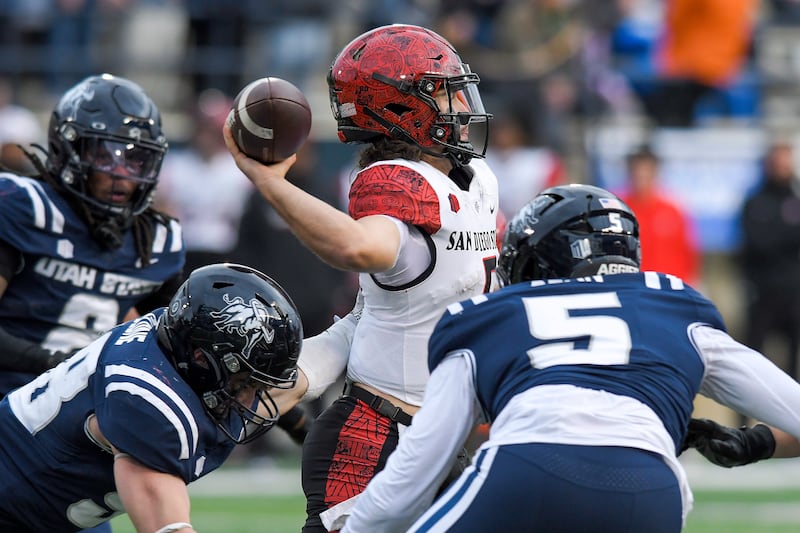Generally speaking, expectations for Utah State football in 2025 aren’t particularly lofty, and it makes sense.
The Aggies are in Year 1 of the Bronco Mendenhall era, have 70 new players on the roster right now and are coming off a 4-8 season.
Even with Mendenhall’s track record, an experienced returner at quarterback in Bryson Barnes and a fairly manageable schedule, there is reason to doubt that the Aggies will be anything more than a run-of-the-mill Mountain West Conference team.
None of that means Utah State can’t be better than expected, though. Just last season, Mendenhall-led New Mexico upset a ranked Washington State team, the Lobos’ first win over a ranked opponent in more than 20 years.
If Utah State is to exceed expectations and pull off an upset or two (there will be plenty of opportunities for upsets) it will be because the Aggies’ defense takes a major step forward, and any step forward on that side of the ball will start with the defensive line.
How poorly did Utah State’s defensive line play last season?

The idea that quarterback is the most important position in football is pretty well accepted, but after QB, there is arguably no more important a position group than the defensive line.
In many ways, defensive fronts are the direct counter for quarterbacks, the chief antagonist in a sport wherein quarterbacks are the main character. More than that, though — after quarterbacks — no position group decides the results of games more than defensive lines. A great line can stymie an opposing offense in a way that linebackers and secondaries simply cannot.
It maybe isn’t always the most exciting for the casual fan, but there is a reason that the teams with the best defensive fronts contend for championships year-in and year-out.
Utah State has struggled mightily up front for years now, but in 2024 especially. Per Pro Football Focus, only one Aggie defensive lineman last season — interior or on the edge — was a top 200 player at their position, and that player, defensive tackle Isaiah Bruce, is no longer on the team. Defensive end Cian Slone — now at NC State — proved solid, but even he was barely a top 400 edge rusher nationally, per PFF.
Injuries were a real issue, with multiple starting defensive linemen (Taz Williams, Miguel Jackson and Blaine Spires) being lost to season-ending injuries, but even when they played the Aggies weren’t particularly good up front. Players played well beneath their proven ability.
Gabriel Iniguez Jr., who was brought in from New Mexico State after an all-Conference USA season, is a particularly good indicator of that. When defensive line coach Donte Wilkins watched film of Iniguez in a Utah State uniform this past winter, he wasn’t enthused about what he saw. Not even close.
“He’s a guy who you look at the film (of last year) and you’re like, ‘What is this? This is unacceptable,’” Wilkins said. “It’s funny, we come in and I looked at film two years ago and (Iniguez) is a a first team all Conference USA player, so my first conversation with him is, ‘What happened? What’s going on?’”
Is there reason to believe Utah State’s defensive line will be better in 2025?

More than any other position group, aside from wide receiver, the Aggies made major changes on the defensive line this offseason in a direct response to the unit’s struggles in years prior.
While some of those changes came at edge rusher, most were at defensive tackle. In came Tyree Morris, Naki Fahina, Kone Aumua-Uiagalelei, Joshua Papu and Carson Tujague, among many others.
Morris, per PFF, has star potential. In his third and final season at Lafayette (FCS), Morris was graded as a top 11 DT at the Division I level (FBS and FCS). Fahina, a transfer from NMSU, was a top 300 defensive tackle last season for those Aggies.
Most importantly, nearly every player USU brought in is big, or has the potential to be. Morris is listed at 6-foot-6 and nearly 275 pounds. Fahina is 6-feet, 300 pounds. Papau is 6-foot-3, 300 pounds. The Aggies are quite simply a lot bigger than they’ve been in years.
“We recruited big people,” Wilkins said. “If you just look at the guys that we brought in, we brought in some height, we brought in some girth.”
That alone should inspire a little more confidence, as USU has fielded undersized defensive fronts for a while now and it was proven a problem, particularly against the best teams Utah State plays (think Boise State, UNLV and power conference competition).
More than that, though, the Aggies appear to have adopted a completely different mindset, one that suits great defensive lines.
“Every time the ball crosses the line of scrimmage in practice, even if it is second and 9, we will have accountability,” Wilkins said. “It is not OK for that ball to move. We talk about building a wall. That is on the defensive line.
“They’re a defensive line for a reason. They’re supposed to be big, they’re supposed to be physical and they’re supposed to be nasty. When they’re on a football field, you’re supposed to be afraid of them.”
If Utah State is to surprise a team or two this season, it will be because the defensive line has improved dramatically. As important as the quarterback position is, “if you can’t keep points off the board, you can’t win games,” linebacker John Miller said, with last season being definitive proof of that again and again for Utah State.
Miller believes the Aggies’ defensive front will indeed be better, which in turn will make help USU’s overall defense vault up from its position as one of the worst in college football.
“The D-line is going to be monsters this year,“ Miller said. ”... I’ve been seeing them work really hard and I’m super excited to see them eat, because they’re all dogs.”

